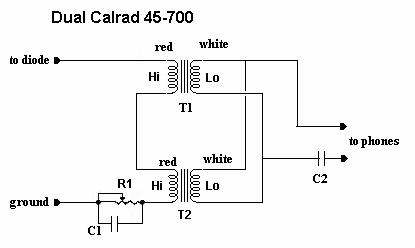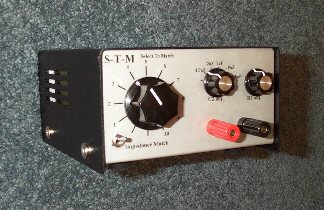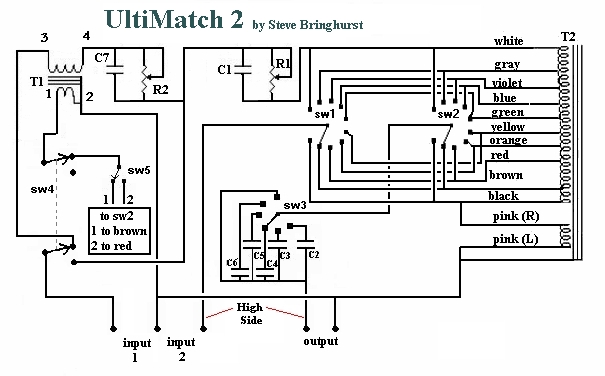
|
|
Impedance Matching
How to
Impedance Match Sound Powered
Headphones
(and other headphones) to Crystal Radios (and just about any other
radio)
Dedicated
Circuits
Stanley Match
by
Mike Tuggle (new)
Select
to Match ("S-T-M")
by Steve Bringhurst
Universal Match-Box
("Uni-Match")
by Steve Bringhurst
UltiMatch and UltiMatch 2
by
Steve Bringhurst (new)
Transformer
Information Page
(Data Sheets and Schmatics
and
where to purchace them)
The Selec-To-Match,
UniMatch,
and UltiMatch
are original concepts by Steven C. Bringhurst The other devices
are
either 'common sense' or suggested by Ben Tongue, and other sources.
With
the exception of the UniMatch, the devices on this page are based on
the
research & ideas of Ben Tongue, without which they would not exist
in the form presented. Our thanks and gratitude are extended to Ben
Tongue
for his work, inspiring this page's contents.
Steve Bringhurst
|
Simple
Dedicated Circuits
Now we will show a very simple circuits,
dedicated
to a particular set of headphones, but first,
you may want to go to Ben Tongue's web
page
and read article #05 (maybe all of the articles).
Ben's Web site is at Welcome to Ben Tongue's Technical Talk
This "fixed" setup is designed for
standard
600 ohm impedance elements wired in series.
It is a standard matching transformer
circuit.

The following is another dedicated
circuit
for two 600 ohm series wired elements.
The transformer is set up more as a
autoformer.
I think it performs a little better than
the
above circuit.

Try both circuits. They use the same
parts!
T1
Calrad
45-700
audio transformer (Ocean Electronic)
R1 250k ohm
pot (a
mini
pot would work great!)
C1 .1uf
capacitor
C2 .47uf
capacitor



Circuit for a UTC A27 Transformer
An excellent very low loss
transformer
(This circuit has been revised
on 29
January
2004)

Dual Calrad 45-700 xformers
Excellent when using Strombergs
Carlson and
Dynalec Decktalkers.
Strombergs are lower AC
Impedance than
most
other sound powered headsets and can
benefit greatly with this
circuit.
This will
help them perform closer to the other "Big Can" decktalkers.
Also works great if using the
"mic"
elements
out of decktalkers.
"Mic" elements are also lower
impedance.
Stanley
Match
by Mike Tuggle

The StanleyMatch combines two
of the
bargain
Fair Radio transformers with a 4-pole, 5-position switch to provide
several
high-to-low impedance matches especially suitable for low impedance
sound
powered phones.
StanleyMatch
by
Mike Tuggle
The StanleyMatch is nothing
radically
different
from other phone matching units, just a way to get more flexibility
from
the Stanley/UTC TF-1A-10-YY input transformers still available at a
bargain
from Fair Radio. By some nifty switching, one can combine two
single
100 k-to-100 ohm units to get five different input-output impedance
pairs.
The key component is the 4-pole, 5-position switch. These come in
the form of 4-deck rotary switches, as 2-deck switches with two
independent
5-position sections on each deck, as shown here (actually, the sections
are 6-position with one position blocked out) -- or possibly as single
deck switches with two independent sections on each side! On a
4-deck
switch several positions will likely need to be blocked out.
That's
what those tabs at the collar are for.
The 2 x 3 x 5 in. mini-box is
about
as small
as I would suggest going -- unless you are a micro-circuitry freak
and/or
don't mind the smell of insulation burning on your soldering
iron.
Even so, I had to pre-wire several of the components before installing
them in the box. Details like exact pot and capacitor value and
connector
types are user's choice. I just happened to have 'standardized'
on
1/4-in. phone plugs and 1/8-in. miniature output jack on my sets.
The low impedance (50 - 200
ohms)
outputs make
this unit especially suitable for low impedance sound powered
phones.
I suppose you could Bogenize the low impedance end to match higher
impedance
magnetic phones. I've been quite happy with SP's and haven't
seriously
tried
other types. The test points (TP) mounted on the rear apron are for
audio
voltage output measurements if so desired.
|

Stanley Match built by Mike Tuggle

S-T-M
"Select to Match"
by Steve Bringhurst
The "Select to Match" was designed to
allow
a person to experiment with different headphones on the same crystal
radio.
If you are using only one set of
headphones
only, you might want to build the
dedicated circuit below which will save
you
space, time and money.
STM
introduction
S-T-M
Calrad/Bogen
"Select to Match"
Impedance
Matching Circuit
Circuit Design by Steve Bringhurst
"baldy3823"

T1
Calrad
45-700 audio transformer (Ocean Electronic)
T2 Bogen
T725
4 watt P/A transformer (Check the bottom of this page)
R1 250k
ohm
variable
resistor
SW1 12 position single
pole
rotary switch
(Radio Shack)
C1 .1 uf
capacitor
C2 Value
of C2
depends
on the set up of the headsets.
(all non polar)
1) one 600 ohm impedance element = 1 uf
2) two 600 ohm impedance. elements wired in parallel = 2.2uf
3) two 600 ohm impedance elements wired in series = .5 uf
4) 10k Hi "Z" headphones = .068uf to .05uf
5) two low "Z" elements in series like Stromberg
Carlsons can be run on 2.2 uf, but 4.7uf might be
a better match up.
Notes:
1) 1 uF is a good
fixed
compromise value for C2 if several different impedance headsets
will be frequently used.
2) The range of C1
can
be
from .05uf to .22uf. It is not that critical.
3) Only ten of the
twelve
positions are used on SW1
4) White lead on
T1 goes
to the rotary switch SW1 with yellow
5) Experimentation
is
the
key to getting the right values on this unit.
What
is right for you and your set up is what counts.
6) See photo below
for
proper
phase ID of the two "pink" wires on the Bogen 725
transformer.

My
version of
Steve's S-T-M
Calrad/Bogen



The S-T-M is excellent for
comparison
of headphones. It works very well for one or two sets of phones as
well.
It will run a range of headphones, from magnetic to sound powered.
More S-T-M circuits using different
transformers
are in the works to be placed here on this page in the near future.
S-T-M
Stanley/Bogen
"Select to Match"
Impedance
Matching Circuit
Circuit Design by Steve Bringhurst
"baldy3823"

T1
Stanley
audio transformer Part Number 227-E-1-3-98
Pri 100 ohm Sec. 100M (100k) ohm
(Fair Radio Sales number T3/AM-20)
T2 Bogen
T725
4 watt P/A transformer (Check the bottom of this page)
R1 250k
ohm
variable
resistor
SW1 12 position single
pole
rotary switch
(Radio Shack)
SW2 6 position single pole
rotary switch
(Radio Shack)
SW3 SPDT toggle switch
(Radio
Shack)
C1 .1 uf
capacitor
(Radio Shack)
C2 4.7
uf
capacitor
non polar (Radio Shack)
C3 2.2
uf capacitor
non polar (Radio Shack)
C4 1.0
uf capacitor
non polar (Radio Shack)
C5 .5 uf
capacitor
non polar (Radio Shack)
C6 .05
uf
capacitor
non polar - not shown in circuit can be
put in for 10k Hi "Z" headphones (Radio Shack)
Notes:
1) The range of C1
can
be
from .05uf to .22uf. It is not that critical.
2) Only ten of the
twelve
positions are used on SW1
4) #1 lead on T1
goes to
SW3. It is split and one lead goes to brown on SW1 and the
other
goes to red on SW1. This allows you to shifts the ratio range a full
step
for better use of the Stromberg Carlson elements.
5) Experimentation
is
the
key to getting the right values on this unit.
What
is right for you and your set up is what counts.
6) See photo below
for
proper
phase ID of the two "pink" wires on the Bogen 725
transformer.

My version of
Steve's
S-T-M
Stanley/Bogen



Universal
Match-Box
"Uni-Match"
by Steve Bringhurst
Another idea from Steve Bringhurst is
the
"Uni-Match"
or Universal Match-Box. This simple box will match just about any
type headphones to just about any type
radio.
Not designed just for crystal radios, but for just about any
type
radio.
"Say you want to use your S/Ps or
Brush-Clevite
piezo's, or your Telephonics TDH-39s or?? on a tube or xistor regenny,
MK-484 TRF, the output of your regular
radio,
ect, ect. You could do any and all with this." Steve
Bringhurst

Starting at the first position on the
switches
and going clockwise the impedance should be approximately
40k, 20K, 10k, 5k, 2.5k. 1.2k, 600, 300,
150,75,
8 (all in ohms)
T2
Bogen T725
4 watt P/A transformer (Check the bottom of this page)
sw1 12 position single
pole
rotary switch
(Radio Shack)
sw2 12 position single
pole
rotary switch
(Radio Shack)
UltiMatch
and UltiMatch 2(new)
by Steve Bringhurst
This is a "All in one
box"
unit
This incorporates the Select to Match
("S-T-M")
and the Universal Match-Box ("Uni-Match")
all in one unit. Get the most out of
your
components!!
Original
UltiMatchCircuit
Original circuit has been left here so
those
who have already
built the circuit can see easily the
differences
in the two circuits.
This will help if you would like to
"convert"
to the new circuit.

UltiMatch 2(new)

Directions for use of
Ulti
Match 2
Input 1
General directions for using the
UltiMatch
with crystal detector receivers;
Crystal detector input is made at
input
1
with the diode to SW4 & the detector return to the other terminal.
1st position of SW-4 is for higher impedance detectors and the 2nd
position
is for lower impedance detector ckts & mineral detectors. SW5
selects
an over-all ratio shift to better match some low impedance headsets at
pos#2, pos#1 is 'normal'. SW5 doesn't function with SW4 in 'low'. R1 is
used to adjust for lowest strong-signal distortion with lower impedance
detectors, R2 is adjusted for lowest strong-signal distortion with very
high impedance detectors like Schottky barrier diodes, otherwise, it's
'normal' setting is 'minimum' with the adjustments for 'low' SW4
setting
and germanium and similar detectors on SW4 'high' being made with R1.
SW2
allows selection of the best match, by ear, of the input device to the
headphone being used. The position giving the loudest & clearest
sound
is usually the best setting. SW3 is used to select bass response
balance
for the headset and input device in use, the 1st position is
'direct'.
This adjustment will have a more subtle effect than a regular tone
control.
Input 2
Input 2 is used for powered
devices like
tube
& transistor detectors & amplifier ckts with SW4 in the 'low'
position.
SW1 is used to select the proper input match for the powered device.
Always
start from the highest setting first when using this function, too low
a setting may damage the powered device. Using SW2 selects the best
match
for the headset as before, or position 1 can drive a loudspeaker
directly.
The loudest & clearest sound is usually obtained when SW1 & SW2
are optimum.
Output
Any set of headphones or single
earpiece,
such as a telephone earpiece, may be connected to the 'output'
terminals.
It is usually preferable to have 2 earpieces connected in series,
rather
than parallel, & properly phased so that the sounds seem to occur
'inside'
ones head between the ears and not 'at' either ear. Switching the
connections
to one earpiece will correct phasing. Some listeners can hear a
definite
difference in intelligibility when the headphone connections to the
transformer
device are switched around (which reverses 'absolute phase'), the
clearer
sound has correct 'absolute phase' and is of course preferable.
It
is generally a one-time adjustment, but not always for every station,
program,
ect . This can change if the station or studio is careless about
engineering
practices and allows reversed absolute-phase signals to occur. If you
cannot
hear a difference when switching the absolute phasing, don't worry
about
it. Many cannot and it's one less thing for you to concern yourself.
Position 1 on SW1 permits use of
an
efficient
4, 8, or 16^ speaker on very loud signals, or use of headsets with very
low impedance ratings similar to those speakers.
Output
Using
Input2/Output
Combo
The 'High' side terminal of input
2 may
be
used as the 'return' for the headset for the xtal detector function if
it is desired to select a winding ratio 'inside' the normal selections.
Connect the headset to the 'high' side output terminal (from SW3) and
it's
other lead to the 'high' side of input 2. SW1 is then used to select a
tap for the 'low' side of the headset connection, SW2 selects the
'high'
side as before. This 'inside' option excludes selection/use of the
position
'1' 8^ speaker tap.Some headsets will match up better using this
option.
Absolute phasing may then
be
reversed/corrected
by reversing the switching order of SW1 and SW2 , thus reversing
the 'high' and 'low' sides of the headphone conections without need to
disconnect and swap them, once the best ratio selection is found by
ear.
Correct "Absolute phase" refers to the the condition where a
pressure
'push' into the studio mic gives a pressure 'push' from the speaker or
headphone. Absolute phase reversal results in an unnatural result
of a 'push' giving a 'pull'. Some listeners find clearer &
more
lifelike voice sounds when absolute phasing is correct.
Steve
Bringhurst
|
Parts List
(UltiMatch and UltiMatch 2)
T1
Stanley
audio transformer Part Number 227-E-1-3-98
Pri 100 ohm Sec. 100M (100k) ohm
(Fair Radio Sales number T3/AM-20)
T2 Bogen
T725
4 watt P/A transformer (Check the bottom of this page)
R1 250k
ohm
variable
resistor #
R2 2 to
3 Meg
ohm
variable resistor
SW1 12 position single
pole
rotary switch
(Radio Shack)
SW2 12 position single
pole
rotary switch
(Radio Shack)
SW3 6 position single pole
rotary switch
(Radio Shack)
SW4 DPST Toggle switch
SW5 SPST Toggle switch
C1 .1 uf
capacitor
C2 4.7
uf
capacitor
non polar (Radio Shack)
C3 2.2
uf capacitor
non polar (Radio Shack)
C4 1.0
uf capacitor
non polar (Radio Shack)
C5 .5 uf
capacitor
non polar (Radio Shack)
C6 .05
uf
capacitor
non polar - (Radio Shack)
C7 .1 uF
Capacitor #
Notes: #
Not used in UltiMatch, only in UltiMatch 2
Bogen T725
transformers can be
purchaced at
Electronics Outfitter $4.06
ea. No
min. order
http://www.electronicsoutfitter.com/eostore/items_html/BOG-T725.html
Lashen Electronics $4.69 ea.
(must
buy 16 at
a time)
http://www.lashen.com/vendors/bogen/Speaker_Transformers.asp
Consolidated Electronics
$5.61 ea.
No min.
order
http://www.ceitron.com/audio/bogen.html
Mar Vac $6.00 ea. No min.
order
http://www.marvac.com/products/bogen/t725_t72510.htm
Modern Radio Labs $7.50 ea.
No min.
order
http://www.modernradiolabs.com/Parts%202.htm
Dave’s Homemade Crystal Radio
Parts
$8.00 ea.
http://www.schmarder.com/radios/sale/parts.htm
Paging Systems Equipment
$10.59 ea.
No min.
order
http://www.pagingsystemequipment.com/Catalog/Model_T725.htm
A-I Consolidated, Inc. $11.99
ea.
No min. order
http://shop.store.yahoo.com/aicons/bogt7t725vol.html
|
Crystal Radio
|
Return
to
"Stay Tuned " Home
Page
© 1999-2010 Darryl Boyd, All rights
reserved
Copyright
Notice:
My website is copyrighted. This includes
all images, text, drawings.
If you are thinking of downloading my
copyrighted items and selling them on ebay (or
anywhere) keep this in mind,
I monitor ebay for such violations. I will
pursue the issue with ebay and in the courts if
necessary.
I do not furnish them for your gain from
my hard work.
Send Email To:
|
|
|
|
|
|
|
|
b |
o
|
y
|
d
|
@
|
b
|
o
|
y
|
d
|
h
|
|
o
|
u
|
s
|
e
|
.
|
c
|
o
|
m
|
Because of antispam
techniques, you
can not "cut and paste" the above text
We have made every effort to ensure
that the information provided on this website is
accurate and up to
date.
All information on this website is informational only
and no guarantees
to the accuracy of any of the projects
or circuits on this site or calculators. If you find
something you feel
is inaccurate, please inform us by e-mail.
Be sure to provide a thorough argument to support your
case. Confirmed
changes will be made as quickly as possible.
The images on this website are protected by
copyright. They
are the property of the owner of this website and may
not be used
without the owners permission. Please don't use the
images made by us on this website without |
|
|

